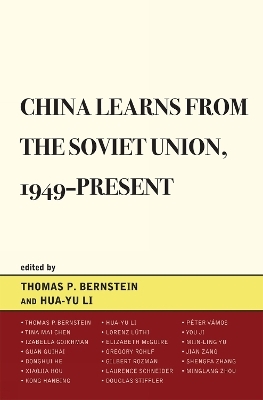
China Learns from the Soviet Union, 1949–Present
Lexington Books (Verlag)
978-0-7391-4222-6 (ISBN)
Thomas P. Bernstein is professor emeritus of political science at Columbia University. Hua-Yu Li is associate professor of political science at Oregon State University.
Chapter 1 Preface Chapter 2 Introduction: The Complexities of Learning from the Soviet Union Part 3 I. The Ups and Downs of Sino-Soviet Relations Chapter 4 1. Sino-Soviet Relations during the Mao Years, 1949-1969 Chapter 5 2. The Main Causes for the Return of the Chinese Changchun Railway to China and its Impact on Sino-Soviet Relations Chapter 6 3. "Only a Handshake but no Embrace:" Sino-Soviet Normalization in the 1980s Part 7 II. Ideological and Military Influences Chapter 8 4. Instilling Stalinism in Chinese Party Members: Absorbing Stalin's Short Course in the 1950s Chapter 9 5. The Soviet Model and the Breakdown of the Military Alliance Part 10 III. Soviet Economic Assistance and Socialist Transformation Chapter 11 6. How to Build a Modern Economy: China Learns from the Soviet Union Chapter 12 7. "Get Organized:" The Impact of the Soviet Model on the CCP's Rural Economic Strategy, 1949-l953 Chapter 13 8. Implementing the Soviet Model of State Farms in China Part 14 IV. Society Chapter 15 9. "Labor is Glorious:" Model Laborers in the PRC Chapter 16 10. The Influence of Soviet Union on Gender Equality in China in the l950s Part 17 V. Soviet Influence on Science and Education Chapter 18 11. The Political Dimensions of Soviet-Chinese Academic Interactions in the l950s: Questioning the Impact -Response Approach Chapter 19 12. "Three Blows of the Shoulder Pole:" Soviet Experts at Chinese People's University, 1950-1957 Chapter 20 13. Lysenkoism and the Suppression of Genetics in the PRC, 1949-1956 Chapter 21 14. Between Revolutions: Chinese Students in Soviet Institutes, 1948-l966 Part 22 VI. Literature and Film Chapter 23 15. Coming of Age in the Brave New World: The Changing Reception of the Soviet Novel, How the Steel was Tempered, in the PRC Chapter 24 16. Film and Gender in Sino-Soviet Cultural Exchange, 1949-69 Part 25 VII. The Era of Reform and the Impact of the Soviet Collapse Chapter 26 17. China's Concurrent Debate about the Gorbachev Era Chapter 27 18. Fate of the Soviet Model of Multinational State-Building in the PRC Chapter 28 19. The Impact of the Collapse of the Soviet Union on China's Political Choices Chapter 29 Concluding Assessment
| Erscheint lt. Verlag | 5.1.2010 |
|---|---|
| Reihe/Serie | The Harvard Cold War Studies Book Series |
| Co-Autor | Thomas P. Bernstein, Tina Mai Chen, Izabella Goikhman, Guiha Guan |
| Verlagsort | Lanham, MD |
| Sprache | englisch |
| Maße | 162 x 240 mm |
| Gewicht | 987 g |
| Themenwelt | Sozialwissenschaften ► Politik / Verwaltung ► Europäische / Internationale Politik |
| ISBN-10 | 0-7391-4222-4 / 0739142224 |
| ISBN-13 | 978-0-7391-4222-6 / 9780739142226 |
| Zustand | Neuware |
| Haben Sie eine Frage zum Produkt? |
aus dem Bereich


